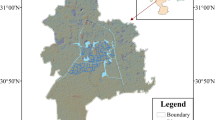Abstract
Scientific assessment of the hydrodynamic conditions of water system connection is of great significance and value in guiding the ecological construction of urban water system connection and building healthy river–lake relationship. Based on the advantages of SWMM in effectively simulating urban rainfall and surface runoff, a hydrological and hydrodynamic model was constructed before and after the implementation of urban water system connection project, and the model was applied to the analysis of rainfall and flooding processes in two recurrence periods of 5a and 10a after the implementation of urban water system connection in Pingyu County. The results show that the initial flow rate and velocity of river cross-section increased in the same recurrence period after the water system connection, the maximum increase of water exchange capacity was 115.56%, the peak flow rate and velocity were weakened and the peak time was lagged, and the hydrodynamic conditions were improved significantly.








Similar content being viewed by others
Data Availability
Data and materials are available from the corresponding author upon request.
References
Cheng ML, Wu W, Yong Y (2019) Hierarchical elimination selection method of dendritic river network generalization. PLoS One 13(12)
Chen S, Zhang XY, Peng LH (2006) Analysis of imperviousness of urban land based on high-resolution satellite images. Resour Sci 06(02):41–46
Jiake L, Deng CN, Li HE (2018) Hydrological environmental responses of LID and approach for rainfall pattern selection in precipitation data-lacked region. Water Resour Manage 32(10)
Jiang L, Gao C, Han L, Sun YJ (2021) River network similarity measurement and analysis for multi-resolution DEM. J Geoinform Sci 23(04):576–583
Karim F, Kinsey-Henderson A, Wallace J (2012) Modelling wetland connectivity during overbank flooding in a tropical floodplain in north Queensland, Australia. Hydrol Process 26(18):2710–2723. https://doi.org/10.1002/hyp.8364
Lane SN, Reaney SM, Heathwaite AL (2009) Representation of landscape hydrological connectivity using a topographically driven surface flow index. Water Resour Res 45(8):53. https://doi.org/10.1029/2008WR007336
Li KX, Li ZW, Hu XY (2020a) Index system and evaluation method of water system connectivity project in Dongting Lake area. Advances in Water Conservancy and Hydropower Science and Technology 40(06):6–10+22
Li L, Guo ZQ, Yang HX, Zhang HX (2020b) Ecological response characteristics of interconnected river system network in Karst Area: a case study of Dabang River basin connecting engineering in Guizhou Province. E3S Web of Conferences 165
Li YL, Tan ZQ, Zhang Q (2021) Refining the concept of hydrological connectivity for large floodplain systems: framework and implications for eco-environmental assessments. Water Res 195
Majid OA, Hamed RZS, Heisam H (2021) Modeling and investigating the effect of the LID methods on collection network of urban runoff using the SWMM model (case study: Shahrekord City). Model Earth Syst Environ 7(1)
Ming D, Lu Y, Meng J (2016) Correlation analysis and threshold value research on the form and function indexes of an urban interconnected river system network. Water Sci Technol: Water Supply 16(6)
Pan JG, Hu P, Yang ZF (2020) Study on the integrated regulation of urban hydrodynamics and water environment in the northern plain. People's Yellow River 42(02):58–62
Shao YL, Xu YP, Ma SS (2012) Analysis of water system structure and river network connectivity changes under the urbanization development of Taihu Lake basin: a case study of Suzhou downtown area. Yangtze River Basin Resour Environ 21(10):1167–1172
Song LX, Xu ZX (2019) Advances in coupled hydrodynamic modeling of urban storm waterlogging. J Beijing Norm Univ (Natural Science Edition) 55(05):581–587
Wang HC, Du PF, Zhao DQ (2008) Global sensitivity analysis of urban rainfall runoff model parameters. China Environ Sci 725–729
Xia J, Gao Y, Zuo QT (2020) Characteristics of river-lake system connectivity and its advantages and disadvantages. Adv Geograph Sci 26–31
Xia J, Zhang Y, Liang CM (2018) A review of urban rainfall flood modeling research. J Wuhan Univ (Engineering Edition) 51(02):95–105
Yang X, Chen G, Sang XF (2016) Water resources optimization simulation of plateau lakes based on river-lake water system connectivity. China Rural Water Conserv Hydropower 205–211
Yang YY, Li J, Huang Q (2021) Performance assessment of sponge city infrastructure on stormwater outflows using isochrone and SWMM models. J Hydrol 597
Zhou Y, Yu MH, Chen YC (2014) Introduction to the estimation method of SWMM sub-catchment area width parameter. China Water Supp Drain 30(22):61–66
Funding
This work was supported by the Key Scientific Research Project of Colleges and Universities in Henan Province (CN) [grant numbers 17A570004].
Author information
Authors and Affiliations
Contributions
All authors contributed to the study conception and design. Writing and editing: Xianqi Zhang and Kai Wang; chart editing: Tao Wang; preliminary data collection: Kai Wang. All authors read and approved the final manuscript.
Corresponding author
Ethics declarations
Ethics Approval
Not applicable.
Consent to Participate
Not applicable.
Consent for Publication
Written informed consent for publication was obtained from all participants.
Competing Interests
The authors declare no competing interests.
Additional information
Publisher's Note
Springer Nature remains neutral with regard to jurisdictional claims in published maps and institutional affiliations.
Rights and permissions
About this article
Cite this article
Zhang, X., Wang, K. & Wang, T. SWMM-Based Assessment of the Improvement of Hydrodynamic Conditions of Urban Water System Connectivity. Water Resour Manage 35, 4519–4534 (2021). https://doi.org/10.1007/s11269-021-02964-7
Received:
Accepted:
Published:
Issue Date:
DOI: https://doi.org/10.1007/s11269-021-02964-7



